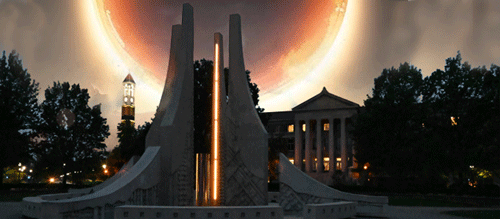Understanding a Solar Eclipse
We are expecting a partial solar eclipse here in West Lafayette, Indiana in the late morning of Saturday, Oct. 14, 2023. The Monday, April 8, 2024, total solar eclipse will go over Purdue University West Lafayette, Indiana just after 3:00 pm EDT.

What is an Eclipse?
An eclipse is a celestial event that occurs when one astronomical object moves into the shadow of another object, resulting in a temporary obscuration or darkening of the first object. The most commonly known types of eclipses are solar eclipses and lunar eclipses. Both solar and lunar eclipses are fascinating astronomical events that have captivated people's curiosity and interest for centuries. We have put together some information, lessons, and resources for you about eclipses.
Background on Solar and Lunar Eclipses:
Solar Eclipse
A solar eclipse happens when the Moon passes between the Sun and the Earth, blocking some or all of the Sun's light from reaching the Earth. From the perspective of an observer on Earth, it appears as if the Moon is covering the Sun. There are three types of solar eclipses: total, partial, and annular, depending on the alignment and positioning of the Sun, Moon, and Earth.Total Solar Eclipse: Occurs when the Moon completely covers the Sun, creating a darkened region known as the umbra on Earth. This allows the Sun's outer atmosphere, the corona, to become visible. Total solar eclipses are relatively rare events that can be observed only from a specific path on Earth.
Partial Solar Eclipse: Happens when the Moon partially covers the Sun, resulting in a partial darkening of the Sun as seen from Earth. In this case, the observer is outside the path of the Moon's shadow, so only a portion of the Sun is obscured.
Annular Solar Eclipse: Occurs when the Moon is positioned at a greater distance from the Earth, and its apparent size is smaller than the Sun. As a result, during the maximum phase of the eclipse, a ring of sunlight remains visible around the Moon.
Lunar Eclipse
A lunar eclipse takes place when the Earth comes between the Sun and the Moon, causing the Earth's shadow to fall on the Moon. This shadow causes the Moon to darken or appear reddish in color. Lunar eclipses are observable from anywhere on Earth where the Moon is above the horizon during the eclipse.
Total Lunar Eclipse: Occurs when the entire Moon passes through the Earth's umbra, resulting in a completely darkened Moon. However, during totality, the Moon can appear reddish due to the Earth's atmosphere bending and scattering sunlight into the Earth's shadow, causing it to reach the Moon.
Partial Lunar Eclipse: Happens when only a portion of the Moon passes through the Earth's umbra, resulting in a partial darkening of the Moon.
Penumbral Lunar Eclipse: Occurs when the Moon passes through the Earth's penumbra, the outer part of the shadow, resulting in a subtle darkening of the Moon. Penumbral eclipses are often less noticeable compared to total or partial lunar eclipses.
Teacher Professional Development
The Purdue University College of Science K-12 Outreach team is offering three Teacher Professional Development opportunities to learn more about how to incorporate these celestial events in your curriculum.
Preparing for the Solar Eclipse in the Science Classroom: (Summer 2023 Middle School PD)
In anticipation of the annular solar eclipse (October 2023) and total solar eclipse (April 2024) events, Purdue University College of Science will be offering an in-person professional development for elementary teachers June 12-13, 2023. Lessons and hands-on activities designed around the eclipse will be developed to help teach science content for the Middle school science curriculum. This PD opportunity will be presented by Purdue staff and faculty, in collaboration with NASA Langley Research Center and MyNASA data. Participants will leave with ready-to-go lessons and materials to teach some lessons.
Link to the agenda for this PD with lesson plans and activities.
Preparing for the Solar Eclipse in the Elementary Classroom: Summer 2023 Elementary PD
In anticipation of the annular solar eclipse (October 2023) and total solar eclipse (April 2024) events, Purdue University College of Science will be offering an in-person professional development for elementary teachers June 15-16, 2023. Lessons and hands-on activities designed around the eclipse will be developed to help teach science content for the elementary school curriculum. This PD opportunity will be presented by Purdue staff and faculty, in collaboration with NASA Langley Research Center and MyNASA data. Participants will leave with ready-to-go lessons and materials to teach some lessons.
Link to the agenda for this PD with lesson plans and activities.
Free Virtual Teacher PD:
In anticipation of the annular solar eclipse (October 2023) and total solar eclipse (April 2024) events, the Purdue University College of Science offered virtual professional development for teaching about eclipse-related content. Lessons and hands-on activities designed around the eclipse will be developed to help teach your science curriculum. This video is a recording of this virtual PD.